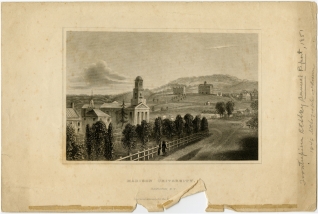resources with the likelihood that it would never “abound in wealth, population, enterprise, and men of education to a sufficient extent for the demands of a great University;”
the absence of manufacturing, commercial, and agricultural advantages in the surrounding area to support a denser population; and the presence of Hamilton College at Clinton, twenty miles distant, which would meet the needs of Central New York. In contrast, the advantages of Rochester were played up in glowing terms. Its youth and rapid growth, which would enhance real-estate investments, was further supported by the agricultural productiveness of the adjacent territory, the rapidly-growing number of wealthy, intelligent and enterprising citizens, the absence of a college in the region except for a small one which the Episcopalians had at Geneva (now Hobart), and the extensive railroad, canal, and lake navigation systems which made the city easily accessible.
News of a possible relocation of Madison University began to appear in the papers of Utica, Syracuse, Auburn, and Rochester, each putting forward the claims of its respective community as a site. Citizens of Rochester, businessmen, and ministers of several denominations, following speeches by Church, Wilder and others at a public meeting on October 28, 1847, unanimously approved the removal project and appointed a committee to raise subscriptions and further the enterprise. Alexander M. Beebee, editor of the Baptist Register of Utica and Sewell S. Cutting, editor of the New York Recorder, a Baptist paper in New York City, duly reported these developments, but discreetly declined to take sides. Cutting, however, expressed regret at no word on the issue from Hamilton.
The proposal to move the institution seems temporarily to have stunned the Hamiltonians, but finally they held a public meeting on November 25, 1847, and, on the motion of Deacon Seneca B. Burchard, appointed a committee to investigate the reasons for and against, the funds invested in University properties, and the prospects for raising an endowment in Madison County. The committee consisted of three lawyers, two businessmen, a physician, and the editor of the Democratic Reflector, none belonging to the Baptist Church:
A few days later an article by “A Citizen”
in the Reflector pointed out that the loss of the University would injure nearly all members of the community. Noting that Syracuse, Utica, and Rochester wanted the University, the writer asked, “Is not the industry and activity of





